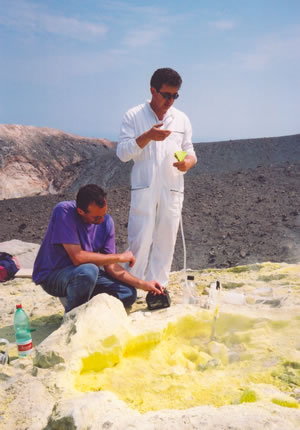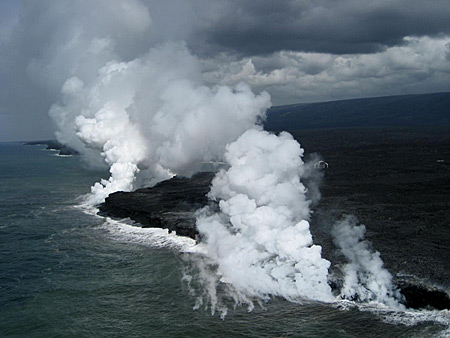Volcanic gas
Volcano Learning Zone > Volcanic Hazards>Volcanic Gas
 Volcanic gases in magma can cause explosive eruptions,give an indication of what the volcano will do next and can even change the earths climate. Sulphur dioxide, carbon dioxide and water vapour are the most common. Gases at the higher pressures deep in the earths crust are dissolved in the melt.
Volcanic gases in magma can cause explosive eruptions,give an indication of what the volcano will do next and can even change the earths climate. Sulphur dioxide, carbon dioxide and water vapour are the most common. Gases at the higher pressures deep in the earths crust are dissolved in the melt.
These gases can escape into the atmosphere gently or violently. Gases can escape through the soil,hydrothermally,fumaroles or vents. As the magma rises the bubbles form and enlarge reducing the density of the melt and aiding its ascent. If the gas bubble volume exceeds the magma volume then an explosive eruption can occur and the magama become ejected as tephra.The most abundant gases are:
- Water H2O
- Carbon Dioxide CO2
- Sulphur Dioxide SO2
- Hydrogen Sulphide H2S
- Hydrogen H2
- Carbon Monoxide CO
- Hydrogen Chloride HCl
- Hydrogen Flouride HF
- Helium He
The most dangerous hazards to humans, animals and people are Sulpur Dioxide,Carbon Dioxide and Hydrogen Flouride. Sulphur dioxide aerosol ( very fine droplets)if ejected high into the atmosphere can reflect the suns energy causing cooling globally and effect the ozone layer. In 1991 the eruption of Mount Pinatubo caused a global temperature drop of 0.5 degrees C. So2 reacts photochemically with sunlight ,water,gas and oxygen and produces VOG a sulphur rich fog. water,dust.
 Volcanoes release 130 million tonnes of CO2 every year something that is not mentioned when people talk of global warming! CO2 is denser than air and will collect in hollows , if the concentration is more than 30% then this can be lethal to life.
Volcanoes release 130 million tonnes of CO2 every year something that is not mentioned when people talk of global warming! CO2 is denser than air and will collect in hollows , if the concentration is more than 30% then this can be lethal to life.
Hydrogen Flouride is a plane yellow gas whih attaches itself to ash. It is an irritant to eyes and skin and causes degradation of bones and teeth. If livestock eat ash covered grass the flourine in the ash will poison and cause bone degradation and eventually death. HF can also cause a caustic acid rain similar to HCl.
When lava enters the sea it boils and vaporises the seawater. Chemical reactions occur which produce a white plume called lava haze or laze. The plume has a high concentration of Hydrochloric acid and a Ph between 1.5 and 2. This concentration is corrosive to skin,eyes,lungs and clothing- avoid standing in a laze cloud!


